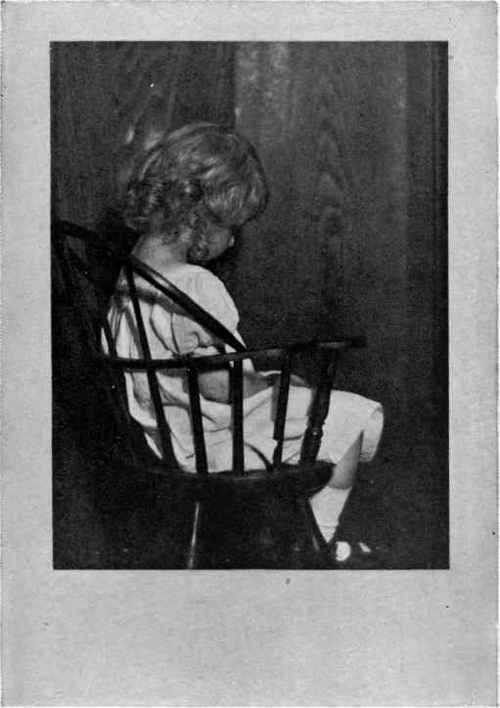At-Home Portraiture. Part II. Controlling The Light. Continued
Description
This section is from the book "Complete Self-Instructing Library Of Practical Photography", by J. B. Schriever. Also available from Amazon: Complete Self-Instructing Library Of Practical Photography.
At-Home Portraiture. Part II. Controlling The Light. Continued
163. Light Falling Properly
Light Falling Properly. If the light falls on the subject at an angle midway between these two extremes, it illuminates both of the eyes, does away with the straight shadow across the face, follows the lines of the face, strikes the little prominences of the various features, accentuating them, and the whole effect is one which pleases and delineates the better characteristics of the individual.

MOTHER AND CHILD Study No. 6 - See Page 402.
Mary G. Huntsman

PUNISHMENT.
Study No. 7 - See Page 402
Helen W. Cook
164. Controlling Light - A Necessity
Controlling Light - A Necessity. From the foregoing it will be understood to be absolutely necessary that some method, or means, be adopted for controlling the light and enabling the production of any desired effect, although it is not necessary to have expensive paraphernalia.
165. Diffusing The Light
Diffusing The Light. Even though the light may fall at the proper angle, there may still be deep shadows on the side of the face farthest from the light. The parts of the face receiving the strongest volume of light may be too white, so it is necessary that the light be further controlled. This is accomplished by placing a piece of thin cloth - such as cheese-cloth or muslin - over the window, softening the light; not only reducing the harshness of the high-lights, but diffusing the light throughout the room so that the shadows receive better illumination. This, then, reduces the amount of contrast and gives a softness which is unobtainable if the hard direct light is allowed to fall on the subject.
166. Reproducing Character
Reproducing Character. It will now be understood that lighting is the art of reproducing character in the subject by correct application of light and shade. We may go on indefinitely and speak of the methods of controlling the light to produce various effects, and to bring out the strongest characteristics of the subject, but as each subject requires individual treatment this is hardly practical. There are, however, general principles and rules which are applicable to all classes of individuals, it having been found by the master portrait painters that one or two particular forms, or styles, of lightings are best suited to the general class of subjects. The photographer who, to a certain extent, has copied after the painters, can also see at a glance that some certain form of lighting is best suited to each subject.
167. Plain Or Broad Lighting
Plain Or Broad Lighting. The lighting most universally favored is termed a Plain or Broad Lighting. This is a lighting in which most of the face is well illuminated, with the light coming a trifle from the front of the subject and falling on the features at an angle of about 45°. The face of the subject should be gradually turned from the source of illumination until the tip of the shadow cast by the nose almost touches the shadow on the shadow cheek. The camera should be placed close to the window, to secure a view of the face that will show most all of it in light. When this effect is secured we have what is known as Plain, or Broad, Portrait Lighting. It is best adapted to the general class of subjects, as the light is thrown onto all parts of the face. If the subject has hollow cheeks, or wrinkles, which should not be exaggerated, but toned down, this form of lighting will be found to be the best to apply.
168. Rembrandt Lighting
Rembrandt Lighting. If the camera were placed to secure the same view of the other side of the face, the majority of the face would be in shadow, and what is photographically known as the Rembrandt Lighting would be secured. This is a strong character lighting, and it is necessary that careful consideration be given to the features of the subject before attempting to photograph to secure this effect. Faces somewhat thin, or with cheeks a trifle hollow, will not give pleasing results. Faces that are full and round photograph best under this particular form of light.
169. It will now be seen that some method of control is absolutely essential, if the character lines of the individual are to be retained and artistic effects produced.
Continue to:


